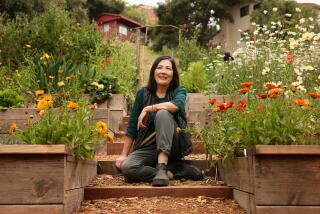Fertilizers Keep Flowers in Bloom : Planting: It will soon be time to finish putting plants in the ground and start feeding them.
- Share via
You can continue the fall planting of bulbs and annuals, vegetables, trees, shrubs and ground covers this weekend, and right on into mid-December, but most spring-blooming flowers and winter vegetables should already be in the ground if you want flowers early in the year.
Now it is time to start fertilizing. The rule is to begin fertilizing about two weeks after planting. In fall and winter, fertilizing is especially important for spring flowers and winter vegetables, to keep them growing strong as the weather cools off. Fertilizing is often the only difference between a good show of flowers and a spectacular show, a decent head of lettuce and a huge head.
Fertilizing in fall and winter is best done with liquid fertilizers because they can more easily be used by plants. Many of the soil organisms, that help a plant convert fertilizer into plant food that can be taken in by the roots, are inactive in the cool weather. Liquid fertilizers are usually formulated to act faster and they bypass the soil organisms, being in a form that plants can directly use. You can find this form on the fertilizer label; it’s called ammoniacal nitrogen and liquid fertilizers usually contain 3% to 6%. They are strong brews.
The kind of fertilizer I am talking about is sometimes sold as a liquid--one brand is Liquinox--but also as small crystals that are then dissolved in water. Spoonit (with a formulation of 18-20-16), Peters Professional (20-20-20) and Miracle-Gro (15-30-15) are examples of fast-acting soluble fertilizers.
All fertilizer labels spell out their contents with three numbers. In 18-20-16, 18 is the total percentage of nitrogen, which may be subdivided further into the various forms of nitrogen; 20 is the percentage of phosphorus, and 16 the percentage of potassium. Nitrogen is by far the most important part since it is directly responsible for growth and is often lacking in California soils.
This is the kind of fertilizer used year round at Sherman Gardens in Corona del Mar to produce what many consider the prettiest flower plantings in the southern half of the state.
Their secret, according to director Wade Roberts, is “consistent watering and fertilizing,” and the techniques used by this small public garden to water and feed work well in home gardens.
They water only the base of the plants with a long, hand-held watering wand that just trickles water to the roots. These wands have baffles at the ends that break the force of the water. Some are shaped like a big shower head and another has a series of flat plates.
Watering by hand this way, they can thoroughly soak the ground without runoff and without wetting the foliage or flowers, which contributes to disease and may topple some plants such as annual stock.
This is not a new way to water bedding plants. When I was a child, my grandfather, who was an accomplished gardener, had me water the pansies and primroses in winter, and the marigolds and zinnias in summer, with a wand.
It was, and is, slow work, but it is also sure. At the time I was too young and impatient to realize how restful this activity was, but I now find it one of the more peaceful jobs in the garden.
At Sherman Gardens, they also use this wand to fertilize with. Every two weeks, like clockwork, they fertilize with a 10-10-5 liquid formulation (Liquinox), applied as they water using a hose-end siphon.
They begin two weeks after planting and continue until the flowers are taken out. Hose-end siphons are little brass valves that go between the hose and the spigot or faucet. A small rubber tube runs from this siphoning valve into a bucket which you fill with water and fertilizer, so you fertilize as you water.
Hozon is one brand, and Hyponex makes another; both sell for around $11 at nurseries. “Anyone who fertilizes any other way is working too hard,” says Roberts about this siphoning device.
The fertilizer must be more concentrated than usual and the directions will tell you how strong to make the fertilizer in the bucket. The Hyponex directions say “16 times,” so if the fertilizer label says to usually add a teaspoon of fertilizer to a gallon of water, you now add 16 teaspoons to every gallon in the bucket.
At Sherman Gardens, they use one other gadget--a little plastic valve between the hose and the watering wand--so they can turn the water off and on between beds. So not only do they water and fertilize most efficiently, but they save water, and until it starts to rain in earnest, that is a very good idea in California.






